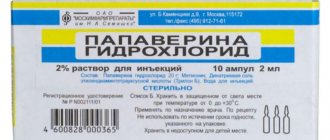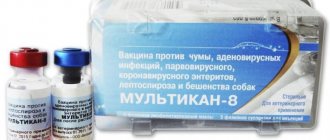Composition and release form
The drug Meningo A+C is manufactured in France. The letters A and C mean that the drug contains polysaccharides of causative agents of meningococcal infections of group A and C serogroups. These types of microorganisms are common causative agents of cerebrospinal meningitis.
The composition of the drug contains:
- purified polysaccharide of meningococcal serogroups A and C (50 μg);
- lactose for lyophilization.
Excipients are sodium chloride and phosphate, as well as water for injection. The drug has a transparent composition and is colorless. The vaccine contains two parts: a lyophilisate necessary for preparing the solution and a solvent supplied by the manufacturer.
The release form is presented in the form of several types of bottles: 1, 10, 20 and 50 doses. For one dose, the solvent is supplied in a syringe with a capacity of 0.5 ml. For a larger number of doses, bottles with a capacity of 5 and 25 ml are produced.
Post-vaccination reactions
Vaccines against meningococcal disease are well tolerated. In 25% of vaccinated people, a post-vaccination local reaction is possible in the form of soreness and redness of the skin at the injection site. Sometimes there is a slight increase in temperature, which normalizes after 24-36 hours. These vaccines are not required for routine immunization in our country, but you need to know about them, especially for those parents whose child is at high risk of developing meningococcal infection, or those who are planning a vacation in countries with unfavorable conditions for the spread of this infection.
pharmachologic effect
The active substance affects the human body through the immune system. The vaccine contains meningococcal antigens that are similar to those found in the causative agent of the disease. The safety of the vaccine lies in special processing.
The polysaccharide antigens that are in the vaccine cannot contribute to the appearance of a real infection, as they are immunogenic. This means that they cause a reaction from the immune system and contribute to the formation of specific immunity.
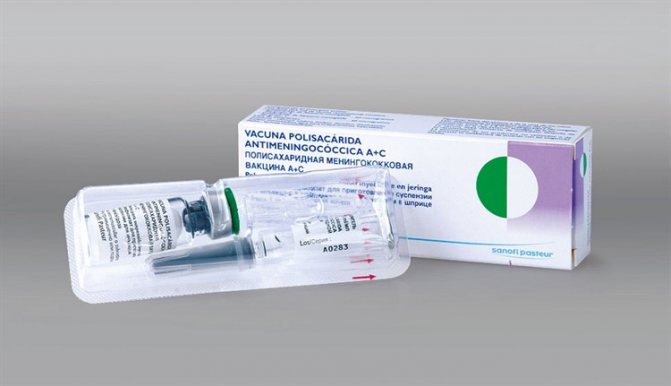
Polysaccharide meningococcal vaccine A+C
After the vaccine is administered, a local inflammation process occurs. It begins to stimulate the immune system, causing the movement of a large number of immunocytes to the site of inflammation, where a collision with meningococcal antigens occurs.
As a result, the human body begins to produce certain antibodies directed against meningococci of serological groups A and C. Immune cells have the ability to remember the structure of antigens. Therefore, when encountering a real infectious agent, it helps to react faster and begin producing specific antibodies earlier.
The introduction of the vaccine provides lasting immunity, which eliminates the possibility of the disease occurring for at least three years.
Meningococcus is not only in Africa
This infection is widespread throughout the world. And in Africa there is even a so-called “meningitis” or “meningococcal belt”:

However, this disease does not only exist somewhere far away, on other continents; unfortunately, it is also close to us. Outbreaks of meningococcal infection are recorded every now and then in different regions of Russia.
For example, in Novosibirsk in 2021, 25 cases of the disease were registered in less than two weeks. And this is very characteristic of this infection: usually long periods of well-being (10-15 years) are interrupted by sharp increases in incidence, which have a focal outbreak nature.
The increase in incidence can be explained by the widespread carriage of meningococcal bacteria. As the number of susceptible individuals increases, the number of cases increases. And declines are ensured by an increase in the immune layer as a result of latent immunization as bacterial carriage spreads among the population of a given territory.
You need to understand that during recession years the infection does not disappear: 50% of diseases occur in children under 5 years of age; 20% - for children aged 6-14 years. As age increases, incidence rates decrease, but carriage rates increase. The age group of 15-20 years is also subject to a high degree of susceptibility, because its representatives - students, military personnel - communicate intensively in schools, dormitories, barracks, etc. First of all, those who come from remote areas get sick, i.e. not previously in contact with the pathogen.
Why are doctors sometimes unable to identify meningococcal infection in the early stages of the disease and provide timely assistance? The fact is that the first symptoms of the disease are similar to the onset of a regular acute respiratory viral infection, and later medicine turns out to be powerless against the lightning-fast course of the disease. Moreover, during periods of prosperity, cases of the disease are so rare that the alertness of even experienced doctors, not to mention young novice doctors, gradually decreases.
One of the features that can also be canceled is that meningococcal infection is characterized by a winter-spring seasonality with the maximum number of diseases in February – April.
There are many real stories about how this can happen, here is one of them (a video from our partners - Sanofi Pasteur):
Indications and preparation for vaccination
The use of polysaccharide vaccine is indicated in the following situations:

- in case of travel to areas that are characterized as epidemically unfavorable;
- as a preventive measure for cerebrospinal meningitis;
- when the epidemic threshold is exceeded in the living region.
Vaccination is also carried out in a situation where the infection spreads in a preschool or school institution (more than two cases of the disease).
Preparing for vaccination requires following some rules:
- it is necessary to exclude allergenic foods from the daily diet;
- If possible, limit contact with large numbers of people before using the vaccine.
A prerequisite is thermometry. If even slight hyperthermia is observed, then vaccination is not carried out.
Before the procedure, the drug must be checked by a healthcare professional. The consistency, color, as well as the presence of impurities or sediment are visually inspected. The expiration date must be checked. The drug is administered intramuscularly.
Instructions for use of the Meningo A+C vaccine
The vaccine is presented as a finely dispersed lyophilisate, which is diluted with the supplied solvent.
Intravenous administration of the drug is strictly prohibited. The kit includes a special syringe that is used to administer the medicine, which has a very thin needle. In addition, it contains a certain mechanism that prevents its reuse.
For a single immunization, one dose of 0.5 ml is used. The vaccine after dilution must be used immediately.
During pregnancy or breastfeeding, the use of Meningo A+S is not allowed.
The drug must be stored in a cool place at a temperature of +2 to +8 degrees. Its shelf life is no more than three years from the date of production.
Contraindications for use

The use of the vaccine is not allowed in the following cases:
- if there are diseases with acute infection;
- during pregnancy and lactation;
- in case of a severe reaction that occurred during the previous administration of a polysaccharide vaccine;
- for progressive diseases occurring in acute or chronic forms.
Possible side effects and complications
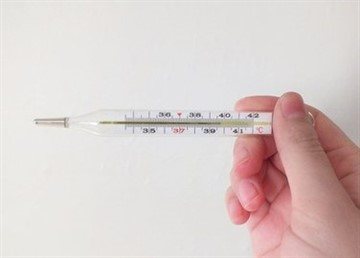
There may be a slight lump, redness or swelling. Sometimes an elevated body temperature (37.5°C) is observed. Such manifestations are considered a physiological reaction of the body that does not require treatment and goes away on its own over time.
Quite rarely, an allergic reaction may occur, manifesting itself in varying degrees of severity. Its most harmless form is urticaria. In this case, it is necessary to take antihistamines.
The most complex allergic consequences are angioedema and anaphylactic shock, which make breathing difficult and significantly reduce blood pressure, which can be dangerous to health and life.
If signs of an allergy appear after vaccination, you should immediately contact a medical facility.
Analogues and substitutes
Preparations for the prevention of meningococcal infection have differences in the combinations of polysaccharides of meningococci of different serological types.
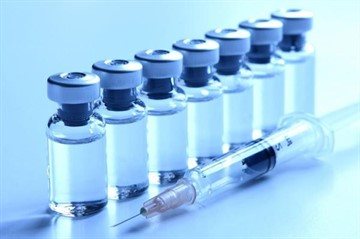
Similar vaccines are:
- Menactra. This is a tetravalent vaccine that contains antigens of meningococci groups A, C, Y and W - 135 serotypes;
- Meningococcal group A vaccine;
- Manveo, is a Swiss analogue, also containing antigens of 4 serotypes of bacteria;
- Mencevax. Quadrivalent vaccine produced in Belgium.
What complications may there be?
As mentioned above, if meningococcal infection is detected late, there is a high probability of death. However, even if treatment was prescribed on time, often the disease does not go away harmlessly. The consequences can lead to a variety of complications, ranging from hearing loss, vision and speech disorders, to amputation of limbs, paralysis, epilepsy and hydrocephalus. And here is another video (video by our partners - Sanofi Pasteur) with a girl who, at the age of 5, suffered a meningococcal infection and was left deaf for the rest of her life:
Reviews and recommendations from doctors
Based on some reviews, we can say with confidence that the drug is easily tolerated and without side effects.
Most people refuse vaccination, citing the fact that the drug can cause meningitis or that it can cause autism in children.
This is not true, since the effects of the drug have been tested many times in clinical studies. Doctors recommend vaccination with Meningo A+C, since its benefits have been confirmed by experience.
With the help of this vaccine, a large number of dangerous infections were prevented.
How does meningococcal infection manifest?
Symptoms depend on the form of infection; When carried, the bacterium can only be detected using laboratory analysis, since there are no external signs. In other cases, symptoms may be as follows:
- acute nasopharyngitis – headache, runny nose or nasal congestion, weakness, increased body temperature;
- meningitis - a sharp increase in temperature, severe pain in the head, vomiting, pulling the legs towards the stomach, the inability to lower the neck and others characteristic of this disease;
- blood poisoning - a sharp increase in temperature, headache, confusion, muscle aches, rashes of varying sizes (most often on the lower part of the body);
- meningoenephalitis - symptoms similar to meningitis, various rashes on the skin and/or mucous membranes
A story from life! Muscovite Yana Savchenko’s 5-year-old daughter died of meningitis in January 2021. Mom and daughter were returning home by train. The girl’s temperature quickly rose to 41˚, her throat turned red, and her body took on the “coping dog” pose (with her legs pressed to her stomach). Upon arrival in Moscow, the child was immediately taken to the infectious diseases hospital, but after some time she died. Everything happened within 24 hours.
There is a test for mengococcal rash. You need to press the side of the glass against the rash-covered skin. It is important that you see the rash through the walls of the glass. If the rash is not visible when pressed, it is not meningococcal.
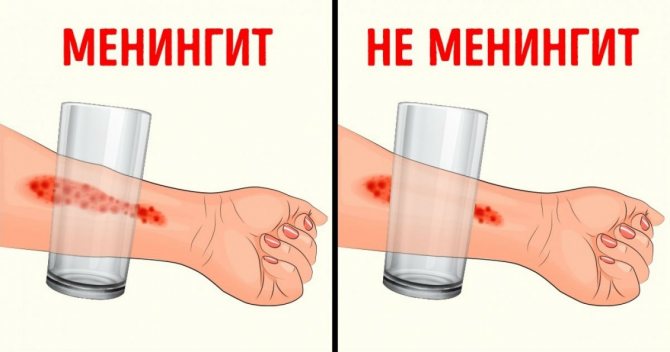
ATTENTION! Due to the high risk of serious complications and even death, at the slightest suspicion of meningococcal infection, you should immediately consult a doctor! Diagnosis is carried out by laboratory examination!



